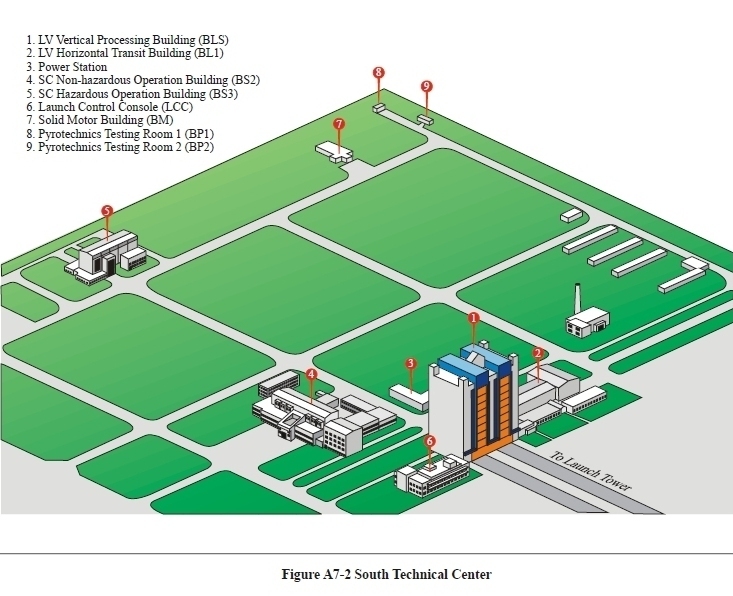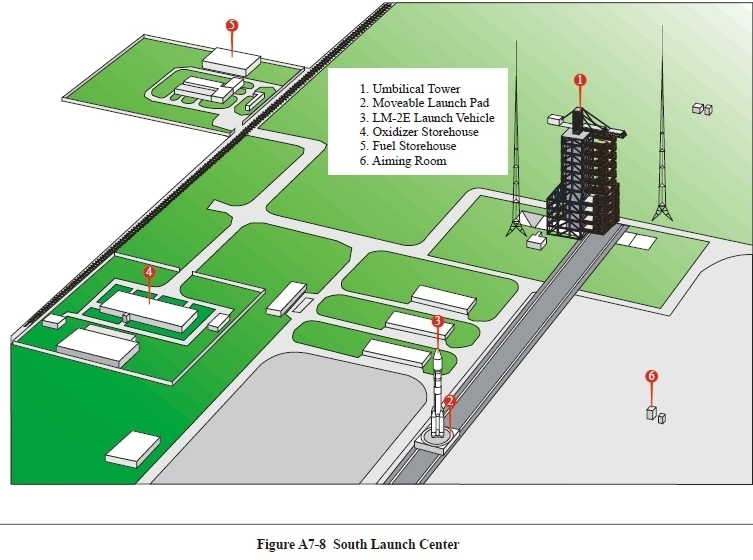North Korea: New Construction at the Sohae Satellite Launching Station
Summary
Recent commercial satellite imagery shows new construction at the Sohae Satellite Launching Station (“Tongchang-ri”), specifically at the site used to launch the Unha space launch vehicle (SLV), most recently in 2012. While the upgrading of the gantry to support a space launch vehicle larger than the Unha was essentially completed by late 2014, Pyongyang has been further modifying the launch area to include a new support building at the east end of the pad as well as a platform that appears to move along rails from that building to the launch tower.
While the exact purpose of this building remains unclear, one possibility is that the North Koreans are building a complex similar to facilities observed in China, such as at the Jiuquan Launch Center, that include buildings where the launch vehicle is assembled, processed, and checked, then placed on a movable platform and rolled to the launch tower. As work moves to completion, a more definitive conclusion will be possible.[1][2]
If the construction is of a new complex, then it raises questions about recent unconfirmed press reports speculating that North Korea could launch a long-range rocket on the 70th anniversary of Korean Workers Party in October 2015. It would appear difficult although not impossible for the construction to be completed in time to prepare for such a launch. However, ongoing work should not preclude an October launch if North Korea were to interrupt construction and conduct those preparations using existing missile assembly and other facilities.
The Sohae facility upgrade program represents a significant investment of financial, material and personnel resources and is another indicator, along with its public statements, that the North is determined to pursue its space program. Moreover, work at the Sohae launch pad points to the fielding of a future SLV larger than the current Unha rocket. A new larger SLV may further contribute to the North’s development of long-range ballistic missiles and provide another sign of Pyongyang’s serious commitment to its space program.
New Construction at the Sohae Launch Pad Progressing
Recent commercial satellite imagery indicates that construction activity begun in September 2014 is progressing at the Sohae launch pad. While the upgrading of the gantry to support a space launch vehicle (SLV) larger than the Unha was essentially completed in late 2014, Pyongyang has been further modifying the launch area to include a new support building on the east end of the pad. A comparison of satellite imagery taken on March 30, April 29 and May 16, 2015 indicates continued progress.
Figure 1. Construction activity at the launch support building and the rail terminus.
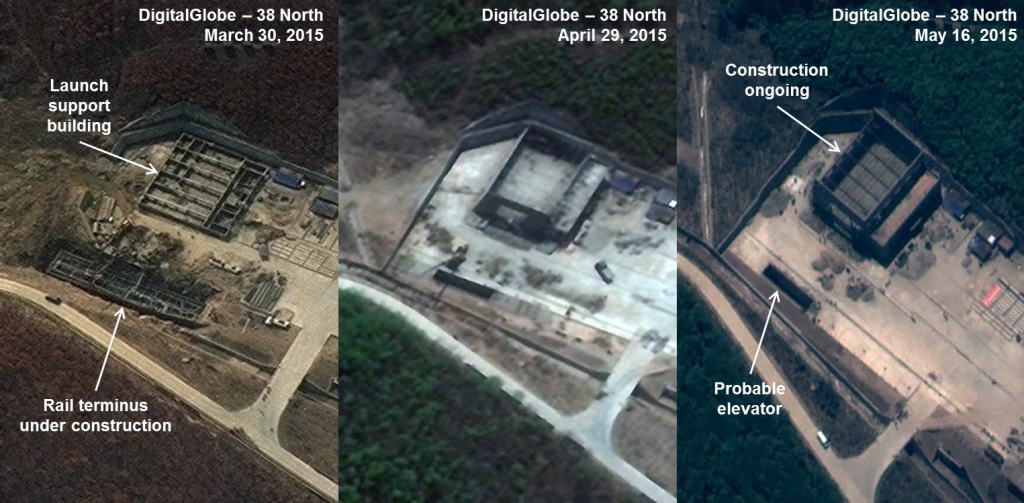
In addition to a rail tunnel terminus that appears to be finished, an April 29 image shows a new platform measuring 30 x 20 meters that moves along the rails from the new building to the launch pad. A slot in the concrete above the underground rail terminus measures 20 x 5 meters and appears to support an elevator that operates from the rail tunnel to the launch pad. Whether the elevator raises rocket airframes or support materials remains unclear at this point. The quantity of construction materials covering the launch pad from March to May has remained in flux.
Figure 2. Ongoing construction activity at the Sohae launch pad.
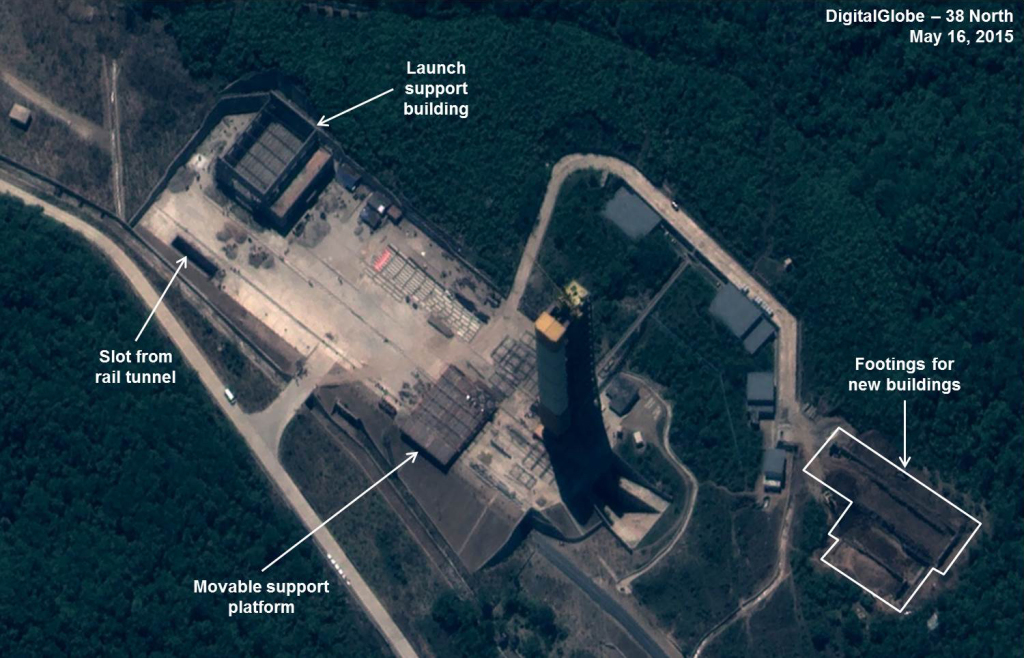
While identifying the exact purpose of the new support building and construction activities at the Sohae launch pad remains difficult until further progress is made, one possibility is that the North Koreans are building a complex similar to ones seen in China that include support buildings where the launch vehicle may be processed assembled or checked-out, then placed on a movable launch platform and rolled to the launch tower. Figures 3 and 4 show the relationship between a vertical processing building at one end and the launch tower at the other, connected by a movable launch pad that transports the rocket/missile at the Jiuquan Launch Center in China. As work moves to completion, the exact purpose will become clear.
Work on a new structure 100 meters to the West of the launch tower is evident as excavation and foundation footings are visible. The purpose of the 1,600 square meter structure is not known at this time.
Figure 3. Vertical processing building, Jiuquan Launch Center, China.[3]
Figure 4. Launch Tower, Jiuquan Launch Center, China. [4]
Missile Assembly Building: Roof Work Ongoing
Work is ongoing on the roof of the main hall of the horizontal assembly building (measuring 53 x 12 meters) which is a “clean room”—a climate-controlled environment designed to minimize airborne particles—where rocket and payload handling, testing and preparation take place. It would be expected that the North would repair and replace the roof as soon as possible. Work is also continuing on a nearby support shed.
Figure 5. Roof repair on the Horizontal Assembly Building.
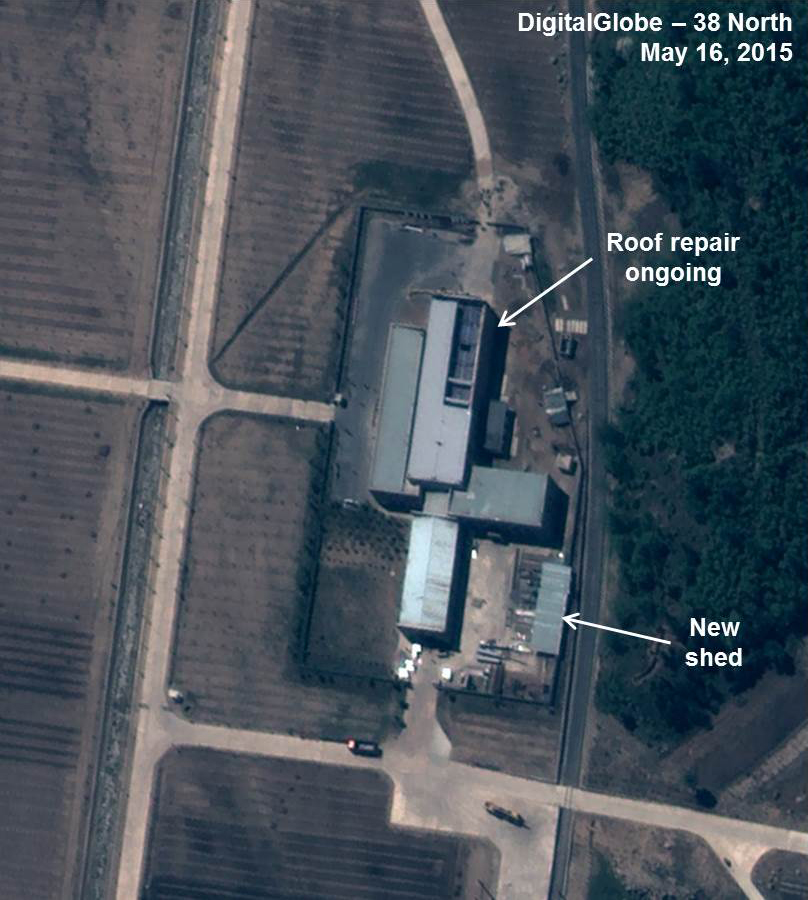
The Rocket Engine Test Stand—No Apparent Change
While Pyongyang conducted a number of rocket engine tests in 2014, there has been no visible activity in 2015. Imagery from March and April shows that vehicles and ground support equipment do not appear to have moved in months; rocket motor sections and support personnel are not present, and there are no burn marks on the blast deflector. The stand appears to be operational.
Figure 6. Rocket Engine Test Stand as of April 29, 2015.

Figure 7. Rocket Engine Test Stand appears operational but no activity.
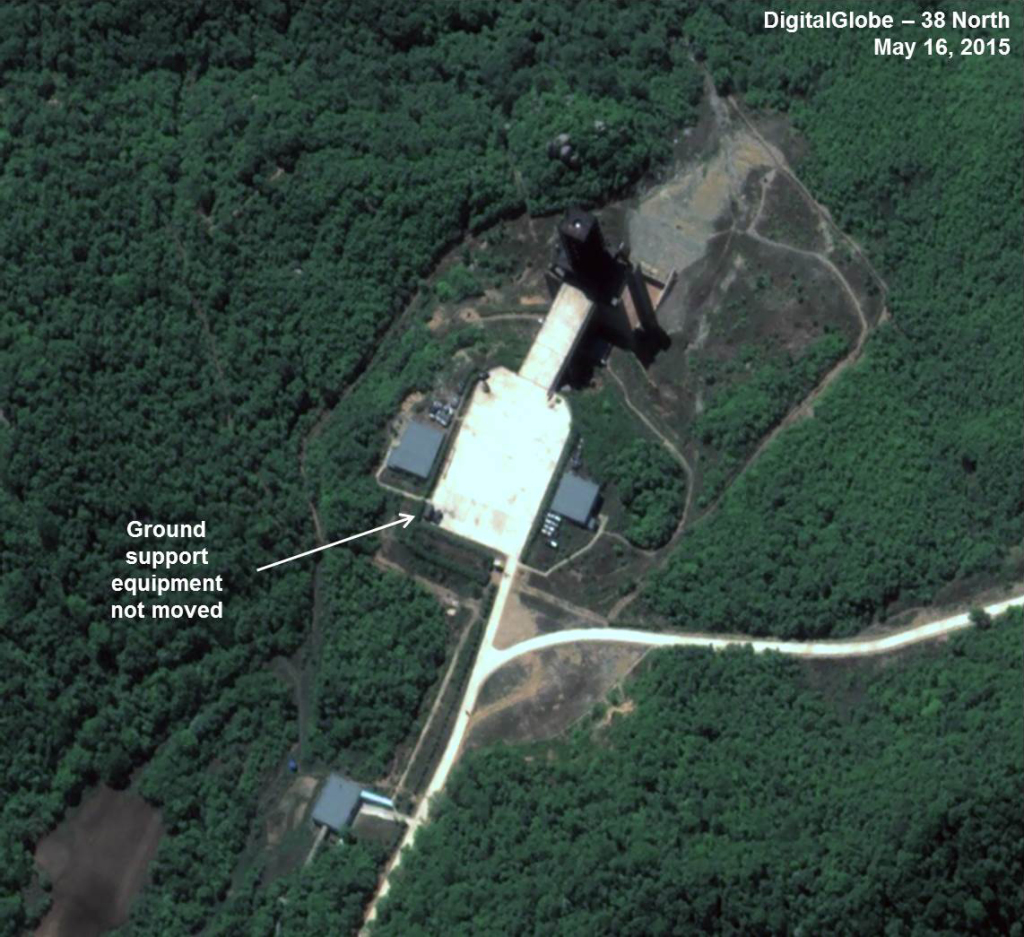
No Activity at the Oval-Shaped Mission Control Building
The silver-colored, oval-shaped building, built in 2014, probably serves as a mission control center that will allow operators to monitor the status and performance of all launch preparation of space craft and payload, telemetry and tracking and range safety. It has an estimated floor space of 3,000 to 4,500 square meters and presumably contains office space, conference rooms, VIP and exhibition space. The mission control building is served by a helipad 120 meters to the west, providing helicopter access to visiting VIPs and leadership.
Figure 8. No activity at the Mission Control Building.
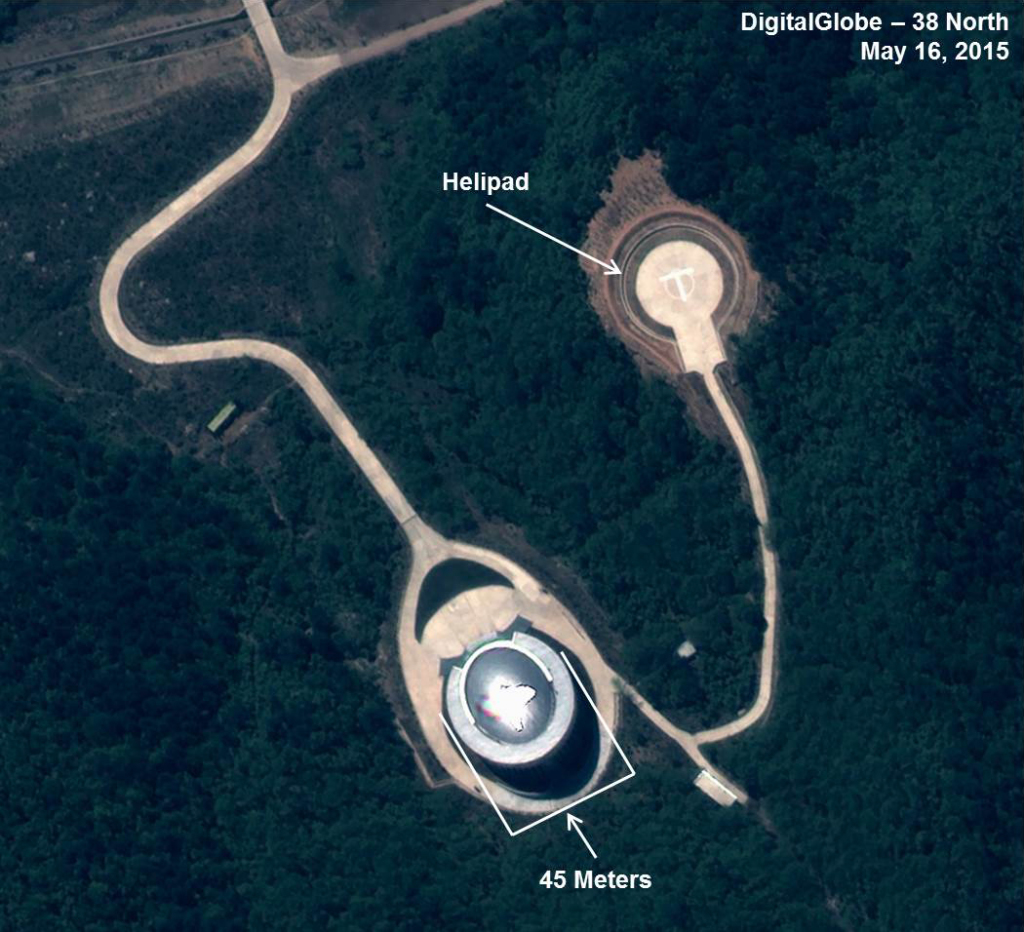
The Instrumentation Site
After considerable construction, expansion and upgrading during 2014, there has been no apparent change at the instrumentation site since imagery from April 29, 2015. A circular pedestal is probably intended to support a tracking antennae.
Figure 9. The instrumentation site.
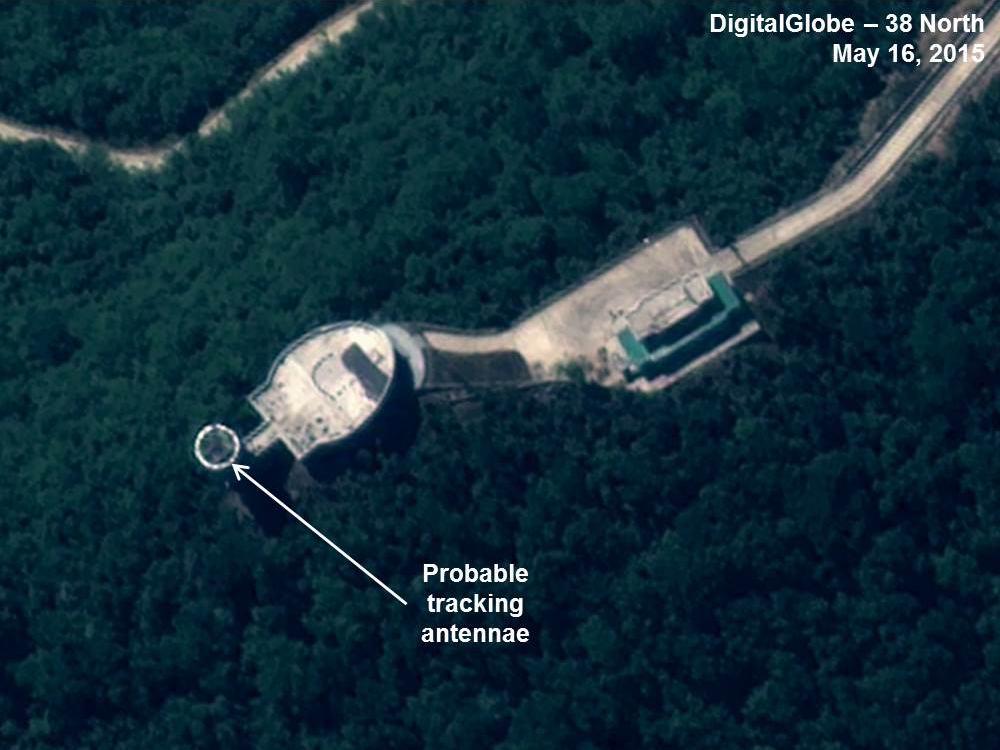
The Western Support/Storage Area
The 30+ support/storage buildings located 1.5 kilometers west of the Horizontal Processing Building have remained unchanged since March of 2015. The facility consists of about four workshop/storage buildings and two military barracks.
Figure 10. The western support/storage area.
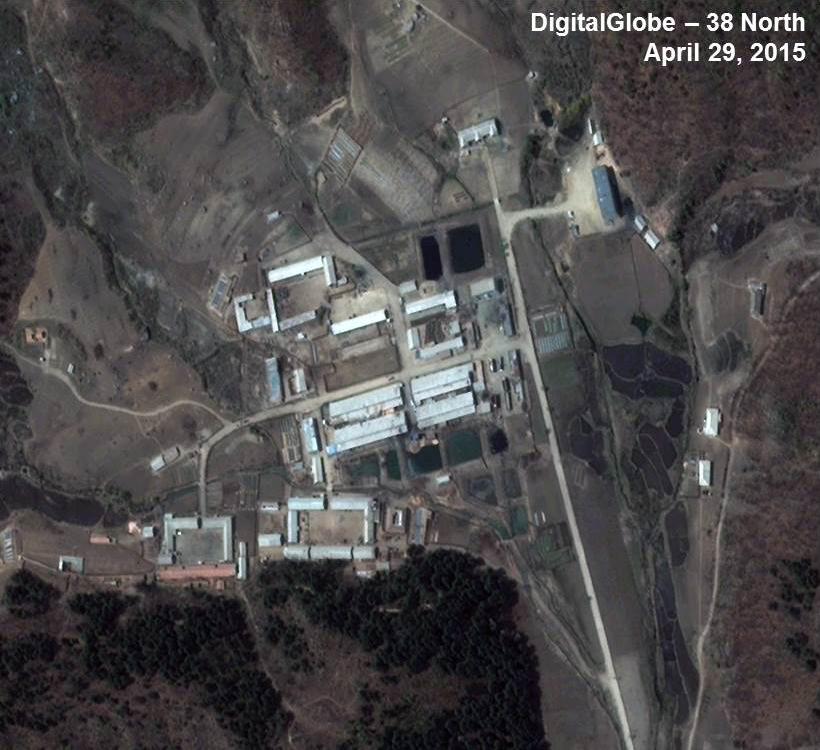
Rail Transfer Point
Construction of a framework for a shed covering rail cars started after late April 2015. When completed, it will cover a portion of both tracks at the rail transfer point. The installation of this structure suggests that it may conceal rail cars from overhead observation. It measures 15 meters, but could extend further when finished. A mobile crane is visible as are rail cars probably associated with construction activity.
Figure 11. Framework for a new shed covering the Rail Transfer Point.
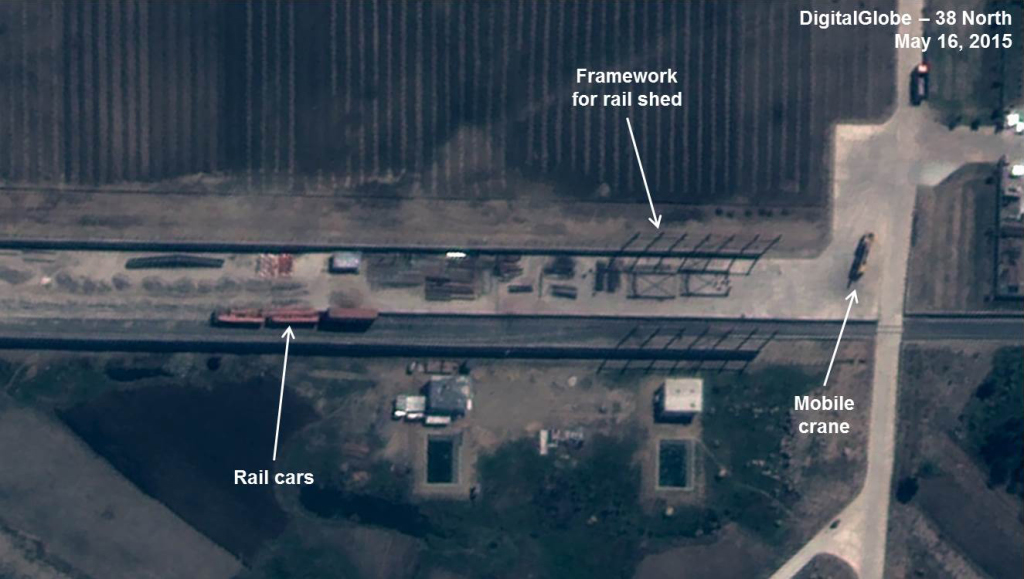
Conclusion
Just as the exact purpose of new construction at the Sohae launch pad remains unclear it is also uncertain when this work will be completed. If the construction is of a new launch complex, then it raises questions about recent unconfirmed press reports speculating that North Korea could launch a long-range rocket on the 70th anniversary of Korean Workers Party in October 2015. It would appear difficult although not impossible for construction to be completed in time to prepare for such a launch. However, ongoing work should not preclude an October launch if North Korea were to interrupt construction and conduct those preparations using existing missile assembly and other facilities.
The Sohae facility upgrade program represents a significant investment of financial, material and personnel resources and is another indicator, along with its public statements, that North Korea is determined to pursue its space program. Moreover, work at the Sohae launch pad points to the fielding of future SLVs larger than the current Unha rocket. A new larger SLV may further contribute to the North’s development of long-range ballistic missiles and provide another sign of Pyongyang’s serious commitment to its space program.
Tim Brown is an Imagery Analyst at GlobalSecurity.org studying nuclear, biological, chemical and missile facilities, in Russia, China, North Korea and a former Security Analyst at the Federation of American Scientists, where he pioneered the use of high resolution commercial satellite imagery and open-source analysis, for public diplomacy.
——————————————-
[1] This similarity is not meant to indicate or infer official Chinese assistance for Pyongyang’s space program. Nor is there any other publicly available evidence to suggest such assistance.
[2] Among the possible functions for the new support building is vertical assembly of the launch vehicle on the movable pad before moving to the launch tower or storage for support vehicles or equipment.
[3] Long March 2E Users Manual, CALT, China 1999, Figure A7-2.
[4] Long March 2E Users Manual, CALT, China 1999, Figure A7-8.

